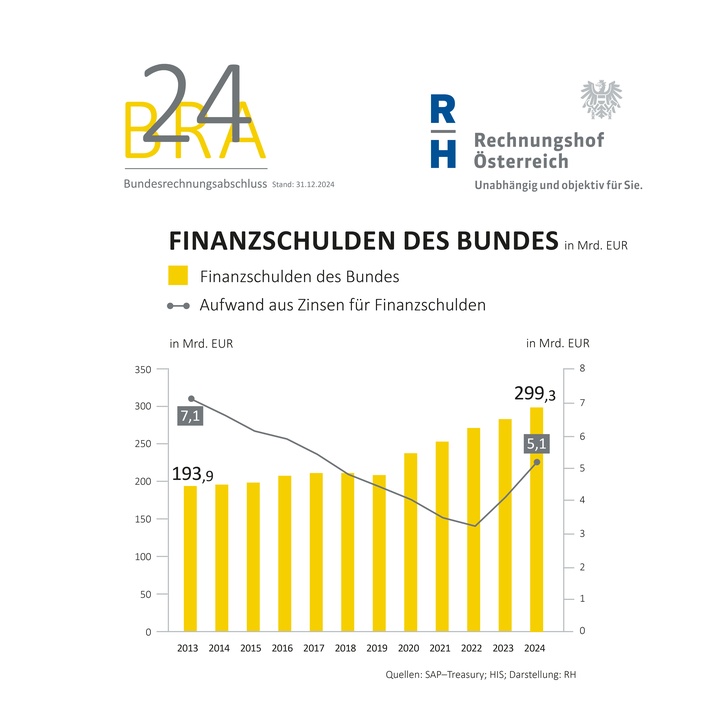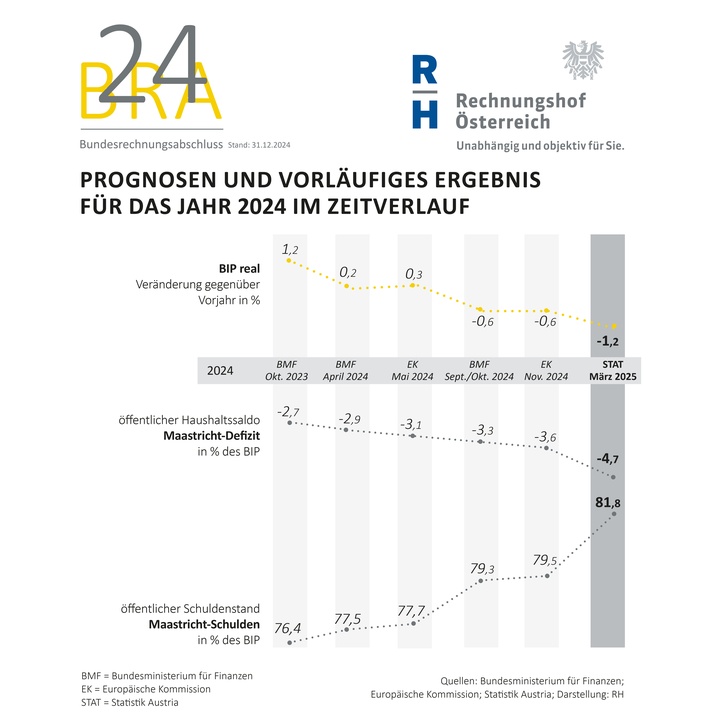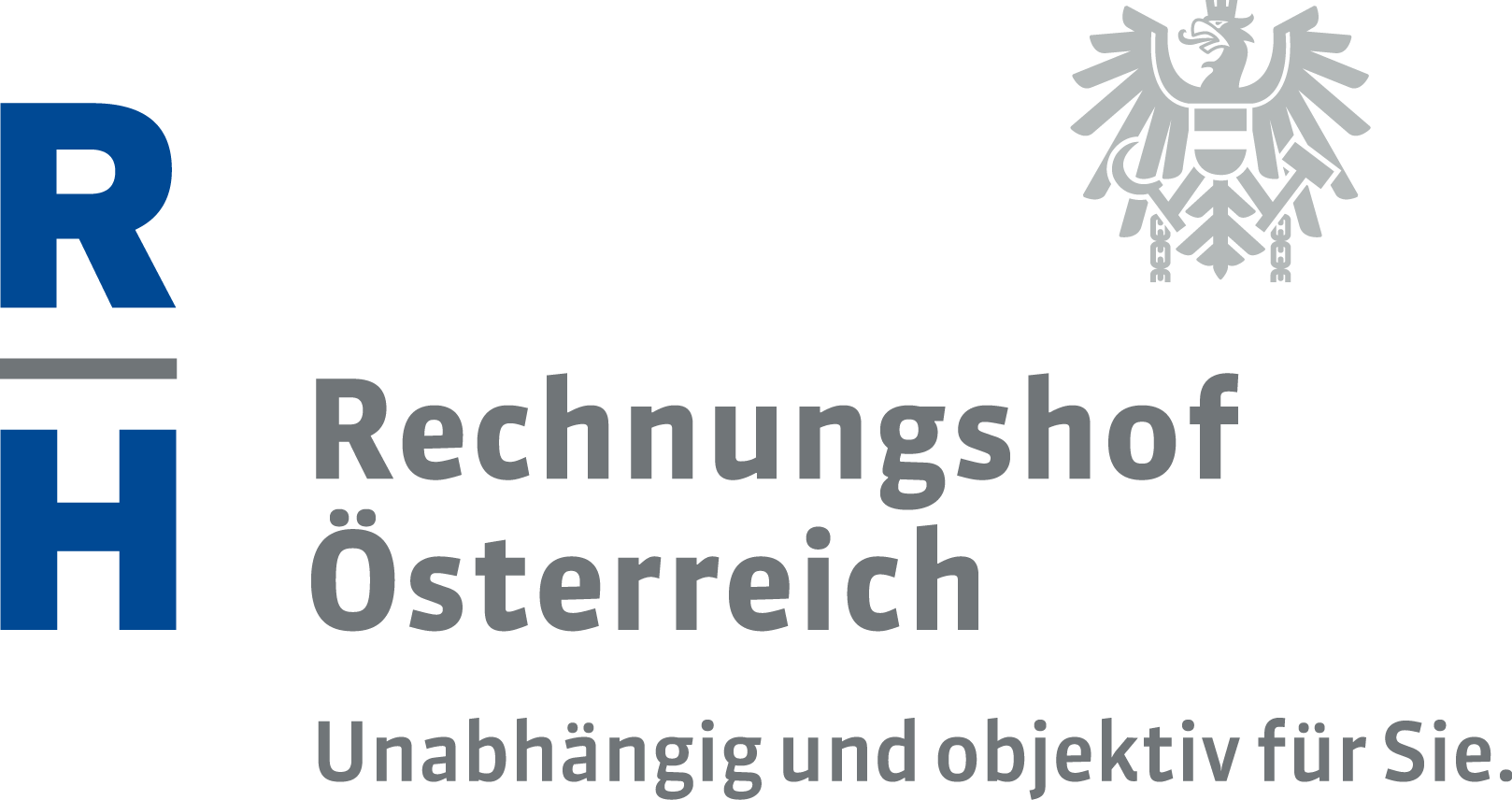Report on the 2024 Federal Financial Statements: reforms in funding-intensive areas are indispensable

In 2024, the federal budget once again recorded a marked negative net result, which amounted to minus EUR 13.755 billion. For the fifth consecutive year, federal financial debt significantly increased to EUR 299.252 billion or 62.1 per cent of the gross domestic product (GDP). The reasons for the increased financing needs: the measures to fight recent crises (COVID-19 pandemic, inflation) and to support the economy, increased interest expense for financial debts incurred since 2023 as well as the significantly higher disbursements for pensions and salaries. These are the findings of the ACA’s report on the 2024 Federal Financial Statements published today. A diligent state should not implement accurate, needs-based and targeted measures without securing appropriate funding. Against this backdrop, the ACA calls for action in order to reestablish budgetary balance and reclaim the ability to act. Due to the general government deficit, which amounted to minus 4.7 per cent of GDP in 2024 and was thus higher than forecast, the ACA is of the opinion that reforms are indispensable.
The status quo: in the 2024 financial year, the domestic economy faced an economic downturn for the second consecutive year and challenging economic conditions for the fifth year running. Domestic GDP declined by 1.2 per cent in real terms. Inflation was at 2.9 per cent, which was significantly lower than in the previous year and slowly approached the European Central Bank’s target of 2.0 per cent.
The federal financial debt increased to EUR 299.252 billion

Since 2019, the federal financial debt has increased by 43.3 per cent or EUR 90.484 billion to EUR 299.252 billion. A total of EUR 66.332 billion in new debt was incurred in 2024. The share of borrowing required to cover the deficits rose significantly again in 2024. Interest expenses on financial debt and other financial expenditure increased to EUR 5.106 billion in 2024. Against this backdrop, the ACA points to the importance of a sustainable budgetary policy. Fiscal leeway will have to be reestablished in order for the state to master its future tasks. A diligent state should not implement accurate, needs-based and targeted measures without securing appropriate funding. Thus, action will have to be taken in order to reestablish budgetary balance and reclaim the capacity to act. The state, too, must demonstrate its competitiveness.
Reforms in the areas of healthcare, pensions, old-age care and education are necessary
The 2024 general government deficit was significantly higher than the Federal Ministry of Finance had previously communicated and economic researchers had expected. In 2024, it amounted to minus 4.7 per cent of GDP; public debt amounted to 81.8 per cent of GDP. According to forecasts, the level of public debt in relation to economic output will reach an all-time high by 2028 and will then remain virtually unchanged. The general government deficit will thus remain well above 4 per cent in 2025 and 2026. In June 2025, the European Commission recommended initiating an excessive deficit procedure for Austria.

In the ACA’s opinion, reforms in the most funding-intensive areas of healthcare, pensions, old-age care and education are therefore indispensable. New steering mechanisms for securing energy supply at affordable prices and for the area of digitalization have to be developed. In addition, state funding schemes should also be assessed for their effectiveness and alignment with their intended targets.
Im Rahmen einer Föderalismusreform gilt es im Besonderen, bei neuen Herausforderungen die jeweilige Regulierungs- und Vollzugskompetenz zweckmäßig und eindeutig festzulegen. Eindeutige Aufgabenzuordnungen verringern Schnittstellenprobleme.
Within the scope of a federalism reform, it is particularly important to define the respective regulatory and enforcement competences appropriately and clearly when facing new challenges. Clear task assignment reduces problems where different competences converge. In the future, fiscal policy measures will require transparent financing. Measures must include all levels of government (Federation, provinces, municipalities, organizational units and social insurance providers) and fulfil the criteria of effectiveness, efficiency and economy. This means that the national fiscal rules as defined in Austria’s 2012 Stability Pact also have to be adapted. With regard to budgetary consequences, it is important that measures have a stabilizing effect on growth and the economy.
Yet again, a marked negative net result
The federal budget recorded a marked negative net result, which amounted to minus EUR 13.755 billion. Revenue increased by EUR 6.871 billion compared to the previous year and reached EUR 105.574 billion, which essentially resulted from higher tax revenue due to increased salary levels and inflation. Expenditure was EUR 9.909 billion higher than in the previous year and reached EUR 119.330 billion. Transfer expenditure experienced the biggest increase (plus EUR 9.286 billion), including in particular transfers to private households for the climate bonus, more funding for renewable energy sources as well as restorations in the building sector and the transfers to social insurance and pension insurance providers due to higher federal contributions. Net assets declined compared to the previous year and amounted to minus EUR 228.639 billion in 2024.
In 2024, a total of EUR 5.766 billion was earmarked for inflation relief measures, both in terms of inflows and outflows. Actual pay-outs totalled EUR 2.642 billion; in 2023, they amounted to EUR 4.122 billion.
Please note that the download of the documents below may take some time due to the large volume of data.
Volume 2 on the subdivisions of the Federation is available in an interactive format for the first time this year:
Interactive graph: Volume 2 subdivisions (in German)
An overview on federal assets and debts is also available in an interactive format:
Interactive graph: Federal assets and debts (in German)
- pdf Datei:
- 888.7 KB
Overview of the Federal Budget 2024 (in German)
- pdf Datei:
- 12,217.8 KB
Text Section Volume 1: Federation (in German)
Text Section Volume 2: Subdivisions (interactive) (in German)
Print view Volume 2 (PDF) (in German)
- pdf Datei:
- 3,548.4 KB
Text Section Volume 3: Debts, Liabilities and Development of Public Finances
- pdf Datei:
- 4,275.0 KB
Text Section Volume 4: Regularity Audit Pursuant to Section 9 of the Court of Audit Act, Compliance Audits and Checks of Accounting Documents as well as Focus Audits 2024
- pdf Datei:
- 5,943.5 KB
Set of Figures: Federation (in German)
- pdf Datei:
- 23,259.2 KB
Detailed Set of Figures: Federation (in German)
- pdf Datei:
- 4,765.9 KB
Set of Figures: Financial Statements of Organizational Units (in German)
Financial Statements in CSV Format (in German)
Statement of Financial Position – Long Version
Operating Statement – Long Version
Cash Flow Statement – Long Version
Statement of Comparison of Budgeted and Actual Amounts Operating Statement – Expenditure
Statement of Comparison of Budgeted and Actual Amounts Operating Statement – Revenue
Statement of Comparison of Budgeted and Actual Amounts Cash Flow Statement – Outflows
Statement of Comparison of Budgeted and Actual Amounts Cash Flow Statement – Inflows
Statement of Comparison of Budgeted and Actual Amounts Cash Flow from Financing Activities – Inflows
Set of Figures: SUBDIVISIONS (in German)
Budget Chapter 01 Office of the Federal President
Budget Chapter 02 Federal Legislation
Budget Chapter 03 Constitutional Court
Budget Chapter 04 Supreme Administrative Court
Budget Chapter 05 Austrian Ombudsman Board
Budget Chapter 06 Austrian Court of Audit
Budget Chapter 10 Federal Chancellery
Budget Chapter 11 Internal Affairs
Budget Chapter 12 Foreign Affairs
Budget Chapter 14 Military Affairs
Budget Chapter 15 Financial Administration
Budget Chapter 16 Public Expenditure
Budget Chapter 17 Civil Service and Sport
Budget Chapter 20 Labour and Employment
Budget Chapter 21 Social Affairs and Consumer Protection
Budget Chapter 22 Pension Insurance
Budget Chapter 23 Pensions – Civil Servants
Budget Chapter 25 Families and Youth
Budget Chapter 31 Science and Research
Budget Chapter 32 Arts and Culture
Budget Chapter 33 Economy (Research)
Budget Chapter 34 Innovation and Technology (Research)
Budget Chapter 42 Agriculture, Forestry, Regions and Water Management
Budget Chapter 43 Climate Action, Environment and Energy
Budget Chapter 44 Financial Equalization
Budget Chapter 45 Federal Assets
Budget Chapter 46 Financial Market Stability
Budget Chapter 58 Financing, Currency Swap Agreements


